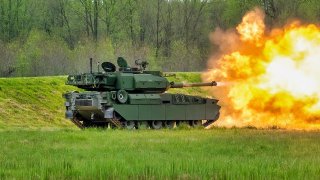Meet the M10 Booker: The U.S. Army’s “Not-a-Tank” Tank
The M10 Booker, the U.S. Army's new light combat vehicle, resembles a scaled-down Abrams tank but is not classified as a main battle tank (MBT). Equipped with a 105mm cannon, advanced sensors, and a four-person crew, it aims to bolster Infantry Brigade Combat Teams (IBCTs).
What You Need to Know: The M10 Booker, the U.S. Army's new light combat vehicle, resembles a scaled-down Abrams tank but is not classified as a main battle tank (MBT). Equipped with a 105mm cannon, advanced sensors, and a four-person crew, it aims to bolster Infantry Brigade Combat Teams (IBCTs).
-Designed in response to lessons from Ukraine's tank losses, the Booker prioritizes agility and survivability in contested environments. While innovative, critics argue the Army should focus on emerging technologies like unmanned ground vehicles and counter-drone systems instead.
-The Booker is seen as a step forward but not a comprehensive solution for modern warfare challenges.
Why the M10 Booker Could Change Modern Combat
America’s newest tank isn’t a tank, according to the United States Army. But just look at the General Dynamics Land Systems (GDLS) M10 Booker and it looks like a miniaturized version of the M1 Abrams Main Battle Tank (MBT). It’s been described as being “crucial” for the US Army’s ongoing transformation that will ensure US ground forces “dominate” during large-scale combat missions. The first unit was delivered to the Army earlier this year in April.
Tests on the new non-tank-tank are scheduled to be conducted in 2025.
This mini-tank comes with a 105 mm cannon and advanced sensors that are meant to enhance the Infantry Brigade Combat Teams (IBCTs). Given a Low-Rate Initial Production (LRIP) order earlier in July, GDLS has received a $322.7 million contract to produce a fleet of these platforms.
The Specs
M10 Bookers is manned by a four-person crew. It has a lightweight hull and turret, a modern diesel engine (sorry environmentalists, the Pentagon has not decided to go fully Green—yet). The M10 has advanced transmission and suspension systems as well. The company plans to have the entire LRIP order fully produced by Fall 2026.
The interesting part about the M10 Booker is the fact that this is clearly a tank masquerading as a light combat vehicle. Indeed, because of the hard lessons learned from the killing fields of the ongoing Ukraine War, the Army is developing a platform that could be decisive against a near-peer rival, such as Russia, if a direct confrontation between the two sides ever erupted.
The Reasons for the Platform
Consider this: the Ukraine War has been terrible for tanks of all classes. Specifically, larger, more modern MBTs. The killing fields have been so bad that Ukraine has discontinued using their NATO-provided Abrams tanks and they’ve basically run out of their Challenger-2 and Leopard-2 MBTs. Meanwhile, the Russians have abandoned all hope of sending their handful of advanced T14 Armatas into the fray for fear of losing them.
For the Russians, they have come to rely upon the old, Soviet-era T-72 whereas the Ukrainians prefer the even older Soviet era T-64 MBT. When the Ukrainians aren’t using these antiques, they are sending the American-produced Bradley Fighting Vehicles that are truly lightly armored vehicles to swarm Russian positions rather than rely on the more advanced, heavier Western MBTs that they were gifted.
Drones and Javelin anti-tank missiles have defined the problem set faced by both sides’ tanks. One of the reasons that the Ukrainians have come to favor systems like the Bradleys is because they are more maneuverable and can get closer to the enemy for the kill. There are stories of Ukrainian-driven Bradleys getting right up to Russian T-72s and firing at them at point blank ranges. Meanwhile, Ukrainians MBTs are getting decimated before they can even get within firing range of Russian tanks by Russian drones and anti-tank weapons.
A System the Russians Fear?
The M10 Booker, as Peter Suciu highlighted in these pages, might be a system that the Russians comes to truly fear. And while the Booker is not up for export and will not be ready to deploy to Ukraine anytime soon, the prospects of this system being used against a rival great power with far greater effectiveness than traditional MBTs cannot be understated.
This is especially because of the “lessons learned” phase of development wherein GDLS engineers actively worked with Army planners to consider all aspects of hardships that US Army personnel might endure in the next great power war.
Still, the M10 Booker seems like a band aid on a larger problem afflicting the United States (and all great powers today): they do not do enough to address the significant disruption that new technologies, such as drones, are having on the modern battlefield.
A Waste of Money
Instead of spending money on what could be an outdated system soon, the Army should be spending money on building unmanned ground vehicles (the Russians are building an arsenal of these things) while developing anti-drone countermeasures.
Nevertheless, the M10 Booker is here and is unlikely to go away anytime soon. The Army has made its investment in this platform. They will now do whatever it takes to justify the expenditure. I’d expect these systems to eventually be made for export to allied nations.
About the Author: Brandon J. Weichert, Defense Expert
Brandon J. Weichert, a National Interest national security analyst, is a former Congressional staffer and geopolitical analyst who is a contributor at The Washington Times, the Asia Times, and The-Pipeline. He is the author of Winning Space: How America Remains a Superpower, Biohacked: China’s Race to Control Life, and The Shadow War: Iran’s Quest for Supremacy. His next book, A Disaster of Our Own Making: How the West Lost Ukraine, is available for purchase wherever books are sold. Weichert can be followed via Twitter @WeTheBrandon.
Image Credit: Creative Commons and/or Shutterstock.
From the Vault


